Consumer Behavior, Irrationality, and Behavioral Economics Assignment
VerifiedAdded on 2021/02/19
|8
|1718
|74
Homework Assignment
AI Summary
This economics assignment delves into fundamental concepts of consumer behavior and behavioral economics. It begins by defining key terms such as consumer indifference curves, marginal rate of substitution, budget constraints, diminishing marginal utility, and income and substitution effects. The assignment then explores behavioral economics, examining the psychological factors that lead to irrational consumer decision-making. It discusses various cognitive biases, discrimination, lack of control, and other factors influencing consumer choices. The solution analyzes how these irrational behaviors impact economic welfare and market dynamics, emphasizing the role of emotional and external influences on purchasing decisions. It includes a comprehensive discussion of how irrational exuberance and herding effects contribute to market instability and financial crises, and finally, the assignment concludes with a review of the literature.

Paraphrase This Document
Need a fresh take? Get an instant paraphrase of this document with our AI Paraphraser
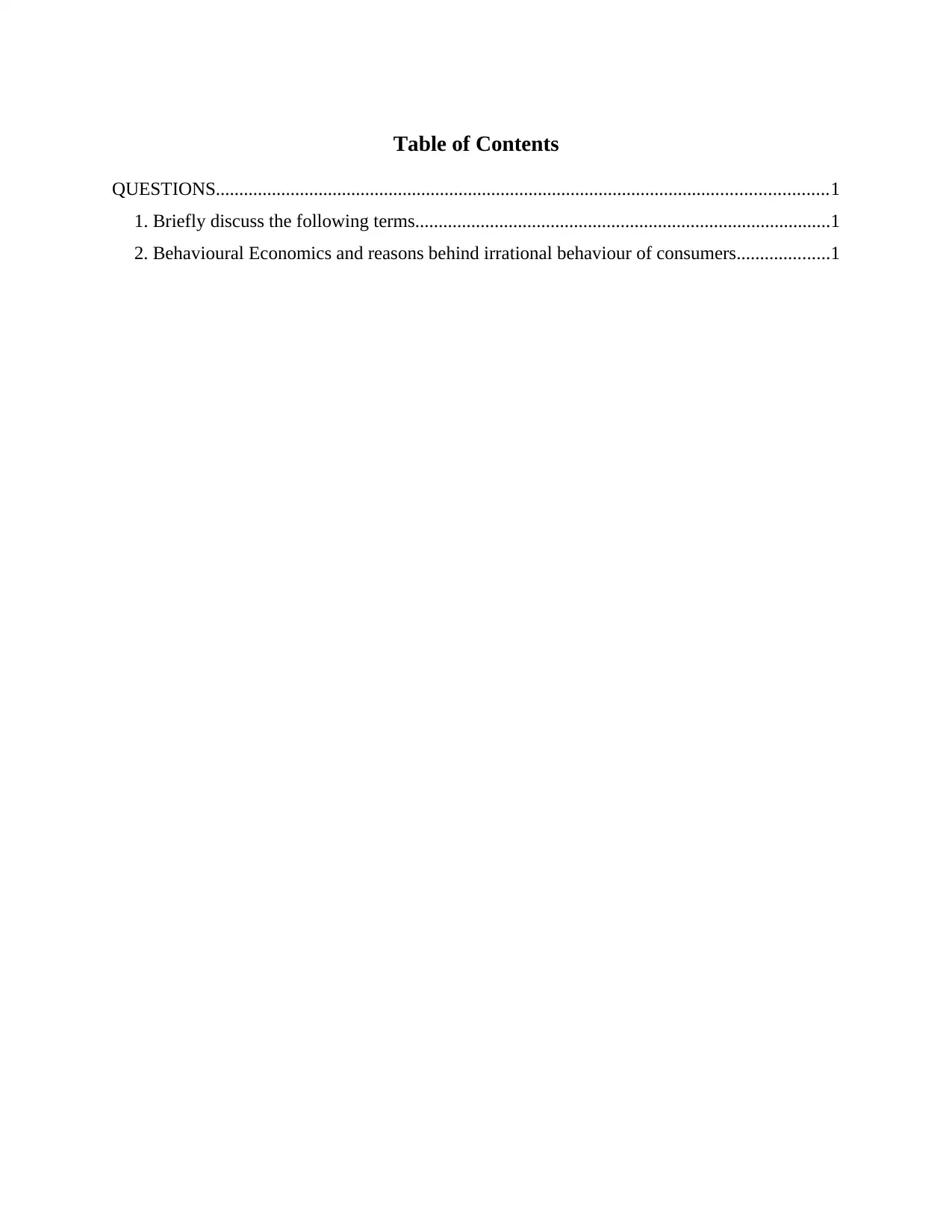
Table of Contents
QUESTIONS...................................................................................................................................1
1. Briefly discuss the following terms.........................................................................................1
2. Behavioural Economics and reasons behind irrational behaviour of consumers....................1
QUESTIONS...................................................................................................................................1
1. Briefly discuss the following terms.........................................................................................1
2. Behavioural Economics and reasons behind irrational behaviour of consumers....................1
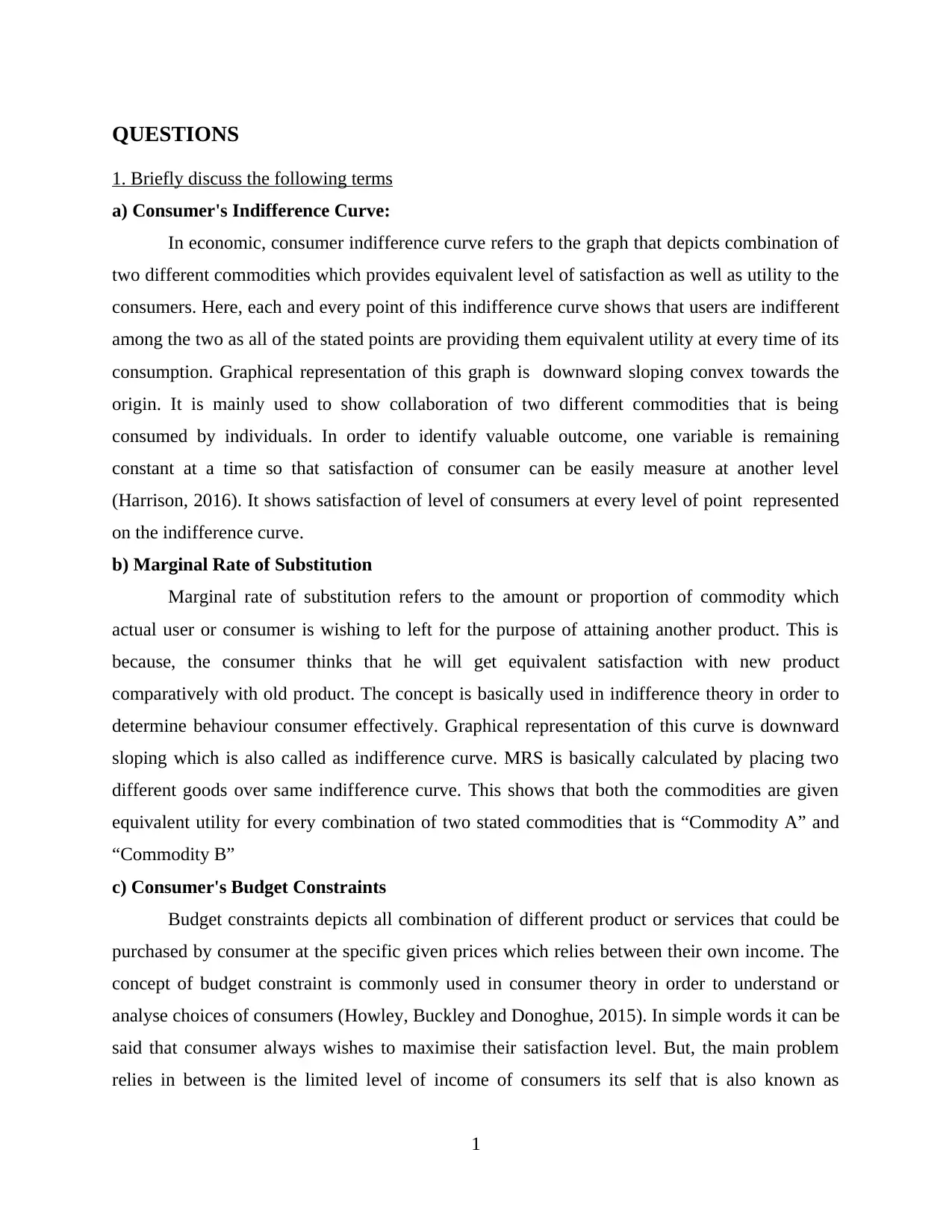
QUESTIONS
1. Briefly discuss the following terms
a) Consumer's Indifference Curve:
In economic, consumer indifference curve refers to the graph that depicts combination of
two different commodities which provides equivalent level of satisfaction as well as utility to the
consumers. Here, each and every point of this indifference curve shows that users are indifferent
among the two as all of the stated points are providing them equivalent utility at every time of its
consumption. Graphical representation of this graph is downward sloping convex towards the
origin. It is mainly used to show collaboration of two different commodities that is being
consumed by individuals. In order to identify valuable outcome, one variable is remaining
constant at a time so that satisfaction of consumer can be easily measure at another level
(Harrison, 2016). It shows satisfaction of level of consumers at every level of point represented
on the indifference curve.
b) Marginal Rate of Substitution
Marginal rate of substitution refers to the amount or proportion of commodity which
actual user or consumer is wishing to left for the purpose of attaining another product. This is
because, the consumer thinks that he will get equivalent satisfaction with new product
comparatively with old product. The concept is basically used in indifference theory in order to
determine behaviour consumer effectively. Graphical representation of this curve is downward
sloping which is also called as indifference curve. MRS is basically calculated by placing two
different goods over same indifference curve. This shows that both the commodities are given
equivalent utility for every combination of two stated commodities that is “Commodity A” and
“Commodity B”
c) Consumer's Budget Constraints
Budget constraints depicts all combination of different product or services that could be
purchased by consumer at the specific given prices which relies between their own income. The
concept of budget constraint is commonly used in consumer theory in order to understand or
analyse choices of consumers (Howley, Buckley and Donoghue, 2015). In simple words it can be
said that consumer always wishes to maximise their satisfaction level. But, the main problem
relies in between is the limited level of income of consumers its self that is also known as
1
1. Briefly discuss the following terms
a) Consumer's Indifference Curve:
In economic, consumer indifference curve refers to the graph that depicts combination of
two different commodities which provides equivalent level of satisfaction as well as utility to the
consumers. Here, each and every point of this indifference curve shows that users are indifferent
among the two as all of the stated points are providing them equivalent utility at every time of its
consumption. Graphical representation of this graph is downward sloping convex towards the
origin. It is mainly used to show collaboration of two different commodities that is being
consumed by individuals. In order to identify valuable outcome, one variable is remaining
constant at a time so that satisfaction of consumer can be easily measure at another level
(Harrison, 2016). It shows satisfaction of level of consumers at every level of point represented
on the indifference curve.
b) Marginal Rate of Substitution
Marginal rate of substitution refers to the amount or proportion of commodity which
actual user or consumer is wishing to left for the purpose of attaining another product. This is
because, the consumer thinks that he will get equivalent satisfaction with new product
comparatively with old product. The concept is basically used in indifference theory in order to
determine behaviour consumer effectively. Graphical representation of this curve is downward
sloping which is also called as indifference curve. MRS is basically calculated by placing two
different goods over same indifference curve. This shows that both the commodities are given
equivalent utility for every combination of two stated commodities that is “Commodity A” and
“Commodity B”
c) Consumer's Budget Constraints
Budget constraints depicts all combination of different product or services that could be
purchased by consumer at the specific given prices which relies between their own income. The
concept of budget constraint is commonly used in consumer theory in order to understand or
analyse choices of consumers (Howley, Buckley and Donoghue, 2015). In simple words it can be
said that consumer always wishes to maximise their satisfaction level. But, the main problem
relies in between is the limited level of income of consumers its self that is also known as
1
⊘ This is a preview!⊘
Do you want full access?
Subscribe today to unlock all pages.

Trusted by 1+ million students worldwide
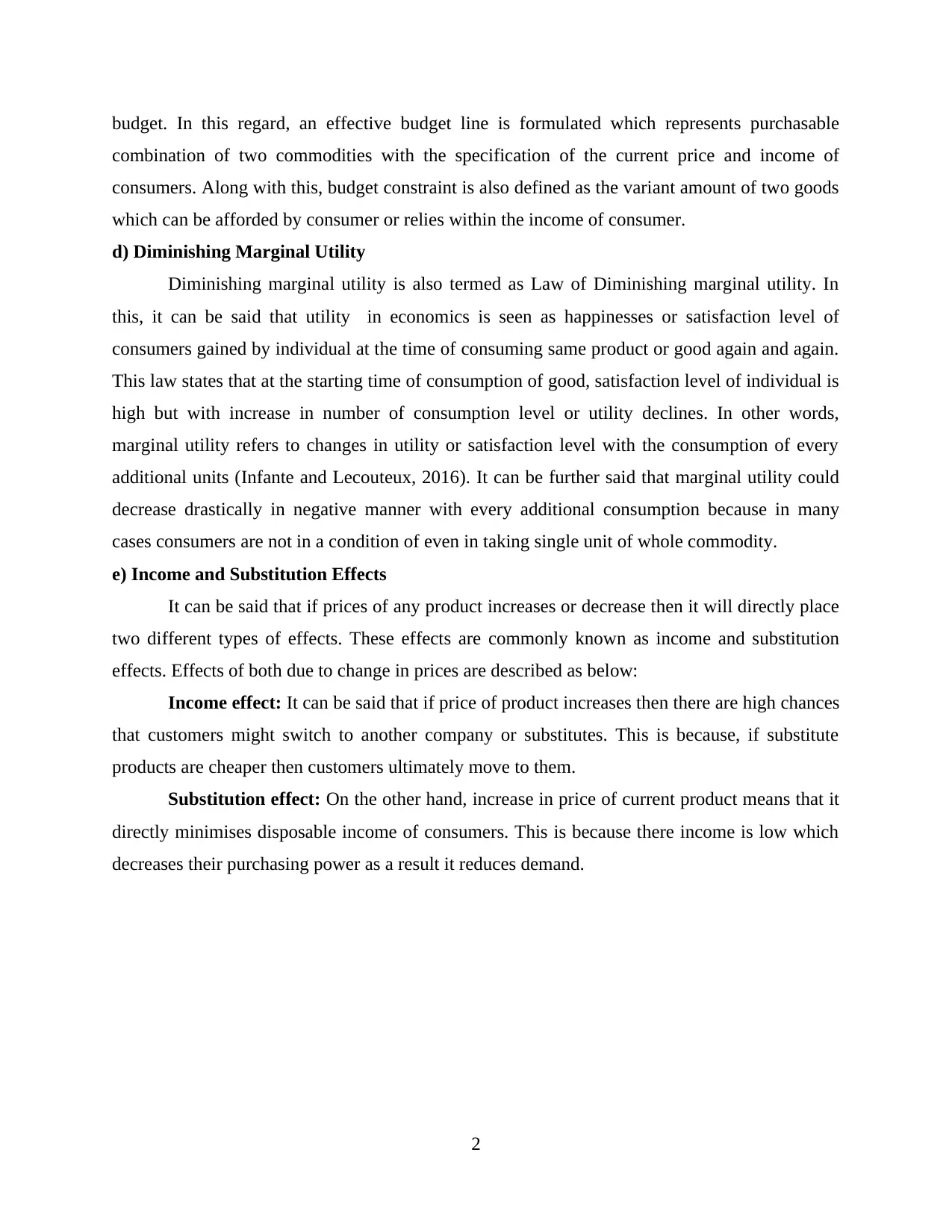
budget. In this regard, an effective budget line is formulated which represents purchasable
combination of two commodities with the specification of the current price and income of
consumers. Along with this, budget constraint is also defined as the variant amount of two goods
which can be afforded by consumer or relies within the income of consumer.
d) Diminishing Marginal Utility
Diminishing marginal utility is also termed as Law of Diminishing marginal utility. In
this, it can be said that utility in economics is seen as happinesses or satisfaction level of
consumers gained by individual at the time of consuming same product or good again and again.
This law states that at the starting time of consumption of good, satisfaction level of individual is
high but with increase in number of consumption level or utility declines. In other words,
marginal utility refers to changes in utility or satisfaction level with the consumption of every
additional units (Infante and Lecouteux, 2016). It can be further said that marginal utility could
decrease drastically in negative manner with every additional consumption because in many
cases consumers are not in a condition of even in taking single unit of whole commodity.
e) Income and Substitution Effects
It can be said that if prices of any product increases or decrease then it will directly place
two different types of effects. These effects are commonly known as income and substitution
effects. Effects of both due to change in prices are described as below:
Income effect: It can be said that if price of product increases then there are high chances
that customers might switch to another company or substitutes. This is because, if substitute
products are cheaper then customers ultimately move to them.
Substitution effect: On the other hand, increase in price of current product means that it
directly minimises disposable income of consumers. This is because there income is low which
decreases their purchasing power as a result it reduces demand.
2
combination of two commodities with the specification of the current price and income of
consumers. Along with this, budget constraint is also defined as the variant amount of two goods
which can be afforded by consumer or relies within the income of consumer.
d) Diminishing Marginal Utility
Diminishing marginal utility is also termed as Law of Diminishing marginal utility. In
this, it can be said that utility in economics is seen as happinesses or satisfaction level of
consumers gained by individual at the time of consuming same product or good again and again.
This law states that at the starting time of consumption of good, satisfaction level of individual is
high but with increase in number of consumption level or utility declines. In other words,
marginal utility refers to changes in utility or satisfaction level with the consumption of every
additional units (Infante and Lecouteux, 2016). It can be further said that marginal utility could
decrease drastically in negative manner with every additional consumption because in many
cases consumers are not in a condition of even in taking single unit of whole commodity.
e) Income and Substitution Effects
It can be said that if prices of any product increases or decrease then it will directly place
two different types of effects. These effects are commonly known as income and substitution
effects. Effects of both due to change in prices are described as below:
Income effect: It can be said that if price of product increases then there are high chances
that customers might switch to another company or substitutes. This is because, if substitute
products are cheaper then customers ultimately move to them.
Substitution effect: On the other hand, increase in price of current product means that it
directly minimises disposable income of consumers. This is because there income is low which
decreases their purchasing power as a result it reduces demand.
2
Paraphrase This Document
Need a fresh take? Get an instant paraphrase of this document with our AI Paraphraser
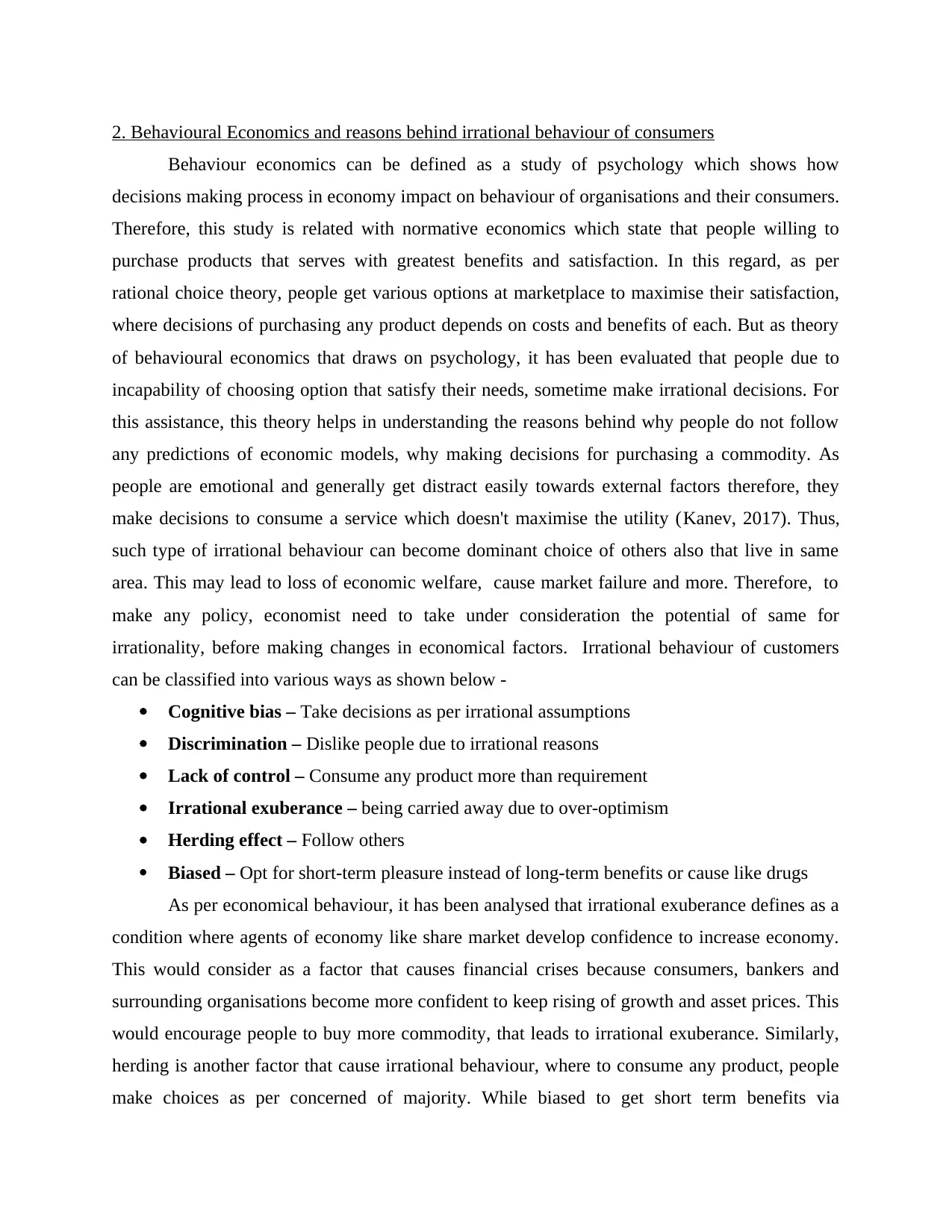
2. Behavioural Economics and reasons behind irrational behaviour of consumers
Behaviour economics can be defined as a study of psychology which shows how
decisions making process in economy impact on behaviour of organisations and their consumers.
Therefore, this study is related with normative economics which state that people willing to
purchase products that serves with greatest benefits and satisfaction. In this regard, as per
rational choice theory, people get various options at marketplace to maximise their satisfaction,
where decisions of purchasing any product depends on costs and benefits of each. But as theory
of behavioural economics that draws on psychology, it has been evaluated that people due to
incapability of choosing option that satisfy their needs, sometime make irrational decisions. For
this assistance, this theory helps in understanding the reasons behind why people do not follow
any predictions of economic models, why making decisions for purchasing a commodity. As
people are emotional and generally get distract easily towards external factors therefore, they
make decisions to consume a service which doesn't maximise the utility (Kanev, 2017). Thus,
such type of irrational behaviour can become dominant choice of others also that live in same
area. This may lead to loss of economic welfare, cause market failure and more. Therefore, to
make any policy, economist need to take under consideration the potential of same for
irrationality, before making changes in economical factors. Irrational behaviour of customers
can be classified into various ways as shown below -
Cognitive bias – Take decisions as per irrational assumptions
Discrimination – Dislike people due to irrational reasons
Lack of control – Consume any product more than requirement
Irrational exuberance – being carried away due to over-optimism
Herding effect – Follow others
Biased – Opt for short-term pleasure instead of long-term benefits or cause like drugs
As per economical behaviour, it has been analysed that irrational exuberance defines as a
condition where agents of economy like share market develop confidence to increase economy.
This would consider as a factor that causes financial crises because consumers, bankers and
surrounding organisations become more confident to keep rising of growth and asset prices. This
would encourage people to buy more commodity, that leads to irrational exuberance. Similarly,
herding is another factor that cause irrational behaviour, where to consume any product, people
make choices as per concerned of majority. While biased to get short term benefits via
Behaviour economics can be defined as a study of psychology which shows how
decisions making process in economy impact on behaviour of organisations and their consumers.
Therefore, this study is related with normative economics which state that people willing to
purchase products that serves with greatest benefits and satisfaction. In this regard, as per
rational choice theory, people get various options at marketplace to maximise their satisfaction,
where decisions of purchasing any product depends on costs and benefits of each. But as theory
of behavioural economics that draws on psychology, it has been evaluated that people due to
incapability of choosing option that satisfy their needs, sometime make irrational decisions. For
this assistance, this theory helps in understanding the reasons behind why people do not follow
any predictions of economic models, why making decisions for purchasing a commodity. As
people are emotional and generally get distract easily towards external factors therefore, they
make decisions to consume a service which doesn't maximise the utility (Kanev, 2017). Thus,
such type of irrational behaviour can become dominant choice of others also that live in same
area. This may lead to loss of economic welfare, cause market failure and more. Therefore, to
make any policy, economist need to take under consideration the potential of same for
irrationality, before making changes in economical factors. Irrational behaviour of customers
can be classified into various ways as shown below -
Cognitive bias – Take decisions as per irrational assumptions
Discrimination – Dislike people due to irrational reasons
Lack of control – Consume any product more than requirement
Irrational exuberance – being carried away due to over-optimism
Herding effect – Follow others
Biased – Opt for short-term pleasure instead of long-term benefits or cause like drugs
As per economical behaviour, it has been analysed that irrational exuberance defines as a
condition where agents of economy like share market develop confidence to increase economy.
This would consider as a factor that causes financial crises because consumers, bankers and
surrounding organisations become more confident to keep rising of growth and asset prices. This
would encourage people to buy more commodity, that leads to irrational exuberance. Similarly,
herding is another factor that cause irrational behaviour, where to consume any product, people
make choices as per concerned of majority. While biased to get short term benefits via
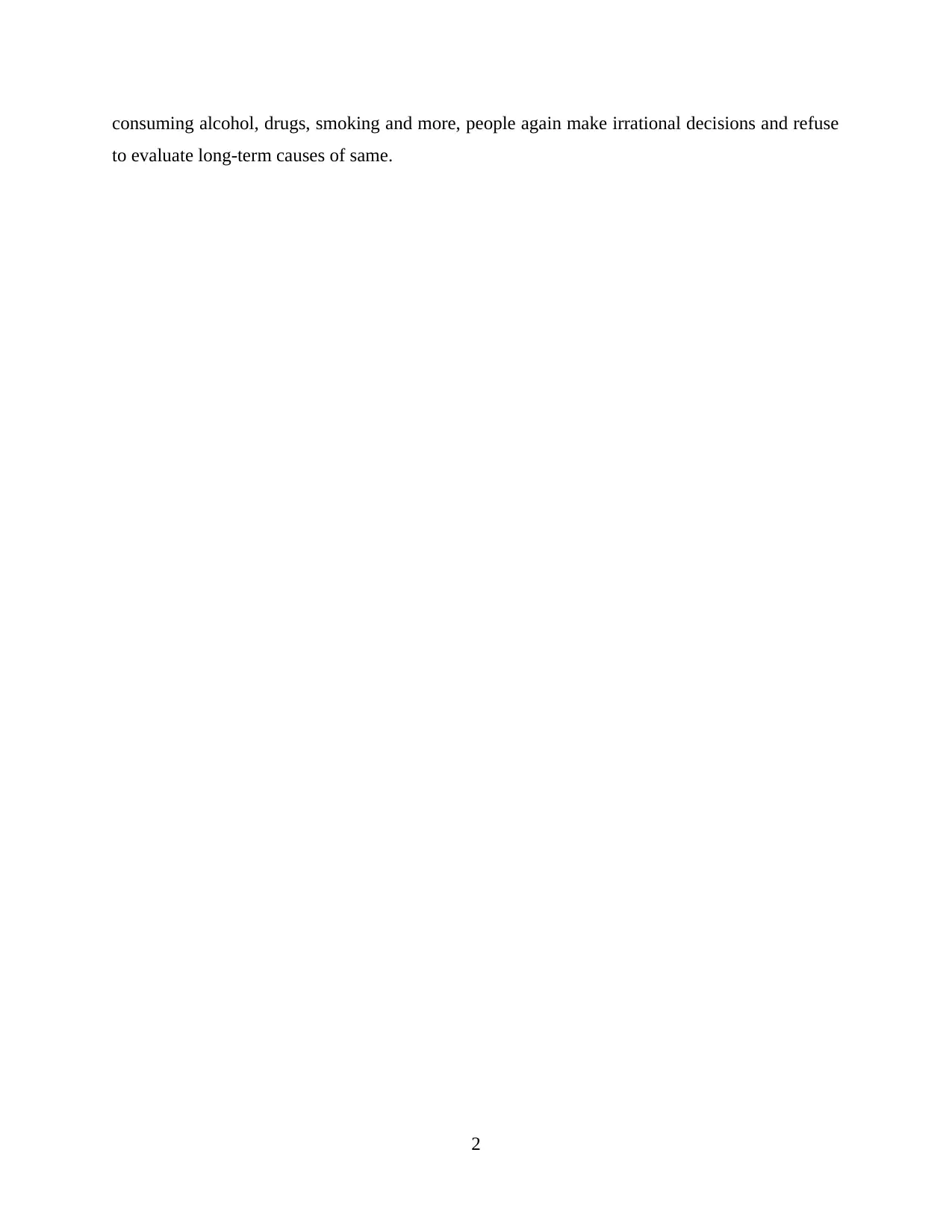
consuming alcohol, drugs, smoking and more, people again make irrational decisions and refuse
to evaluate long-term causes of same.
2
to evaluate long-term causes of same.
2
⊘ This is a preview!⊘
Do you want full access?
Subscribe today to unlock all pages.

Trusted by 1+ million students worldwide
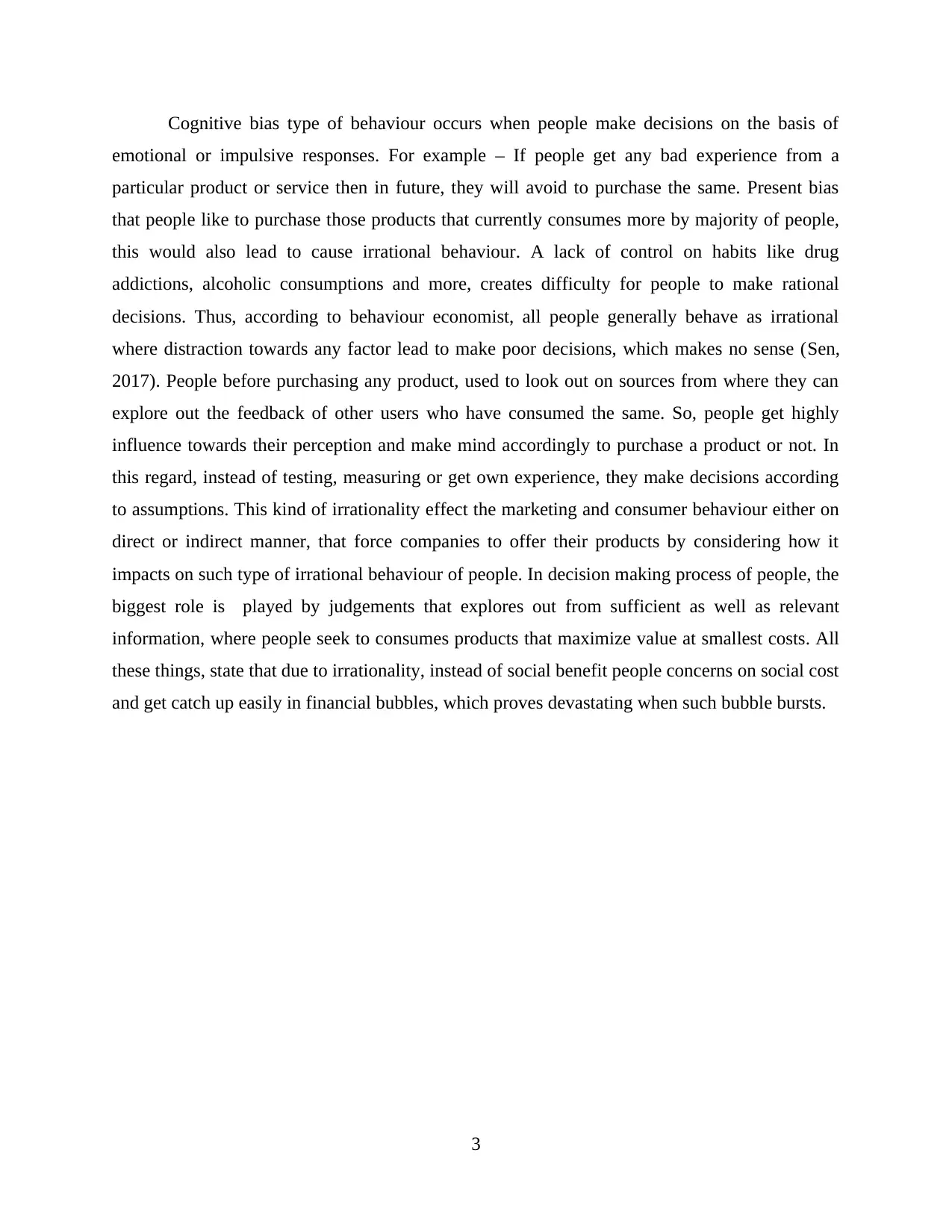
Cognitive bias type of behaviour occurs when people make decisions on the basis of
emotional or impulsive responses. For example – If people get any bad experience from a
particular product or service then in future, they will avoid to purchase the same. Present bias
that people like to purchase those products that currently consumes more by majority of people,
this would also lead to cause irrational behaviour. A lack of control on habits like drug
addictions, alcoholic consumptions and more, creates difficulty for people to make rational
decisions. Thus, according to behaviour economist, all people generally behave as irrational
where distraction towards any factor lead to make poor decisions, which makes no sense (Sen,
2017). People before purchasing any product, used to look out on sources from where they can
explore out the feedback of other users who have consumed the same. So, people get highly
influence towards their perception and make mind accordingly to purchase a product or not. In
this regard, instead of testing, measuring or get own experience, they make decisions according
to assumptions. This kind of irrationality effect the marketing and consumer behaviour either on
direct or indirect manner, that force companies to offer their products by considering how it
impacts on such type of irrational behaviour of people. In decision making process of people, the
biggest role is played by judgements that explores out from sufficient as well as relevant
information, where people seek to consumes products that maximize value at smallest costs. All
these things, state that due to irrationality, instead of social benefit people concerns on social cost
and get catch up easily in financial bubbles, which proves devastating when such bubble bursts.
3
emotional or impulsive responses. For example – If people get any bad experience from a
particular product or service then in future, they will avoid to purchase the same. Present bias
that people like to purchase those products that currently consumes more by majority of people,
this would also lead to cause irrational behaviour. A lack of control on habits like drug
addictions, alcoholic consumptions and more, creates difficulty for people to make rational
decisions. Thus, according to behaviour economist, all people generally behave as irrational
where distraction towards any factor lead to make poor decisions, which makes no sense (Sen,
2017). People before purchasing any product, used to look out on sources from where they can
explore out the feedback of other users who have consumed the same. So, people get highly
influence towards their perception and make mind accordingly to purchase a product or not. In
this regard, instead of testing, measuring or get own experience, they make decisions according
to assumptions. This kind of irrationality effect the marketing and consumer behaviour either on
direct or indirect manner, that force companies to offer their products by considering how it
impacts on such type of irrational behaviour of people. In decision making process of people, the
biggest role is played by judgements that explores out from sufficient as well as relevant
information, where people seek to consumes products that maximize value at smallest costs. All
these things, state that due to irrationality, instead of social benefit people concerns on social cost
and get catch up easily in financial bubbles, which proves devastating when such bubble bursts.
3
Paraphrase This Document
Need a fresh take? Get an instant paraphrase of this document with our AI Paraphraser
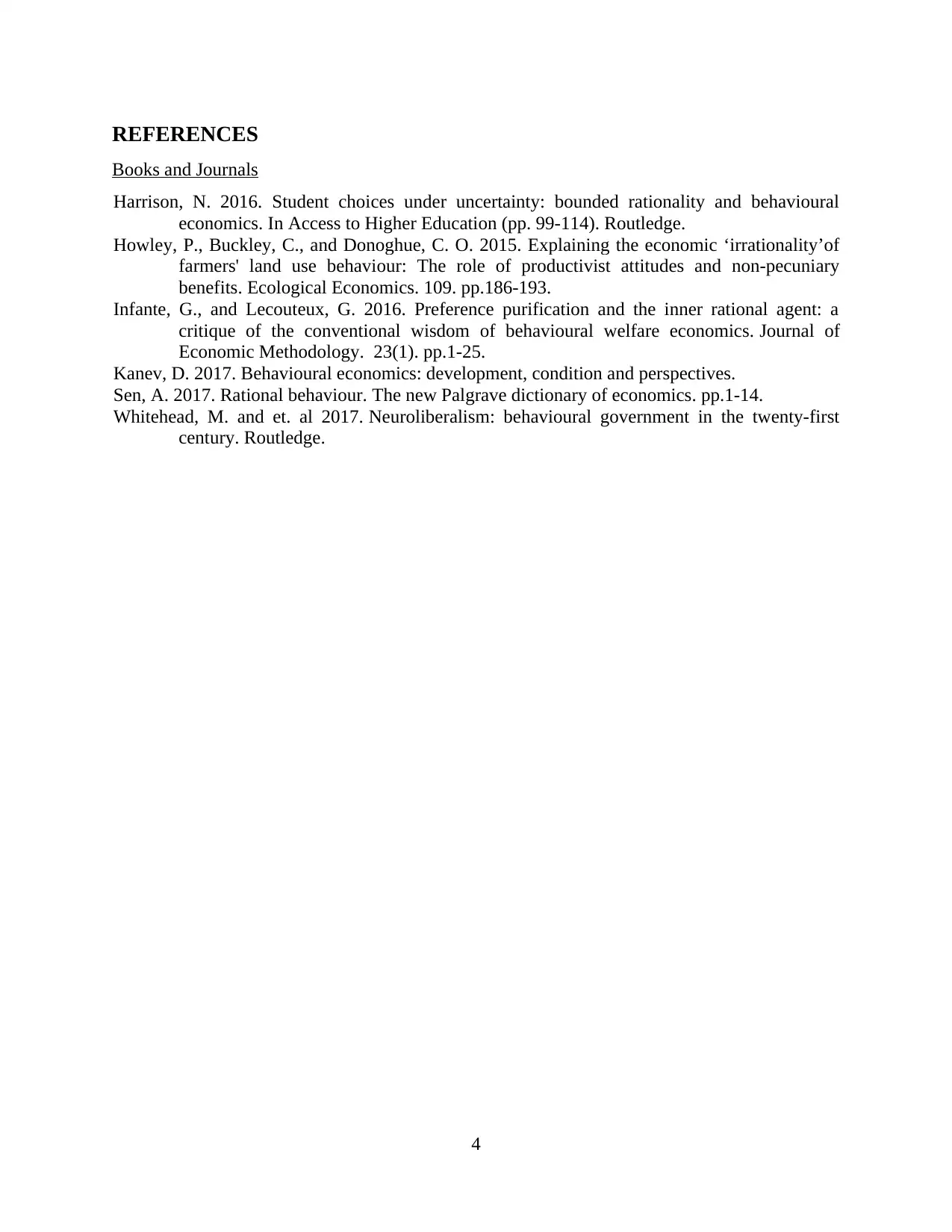
REFERENCES
Books and Journals
Harrison, N. 2016. Student choices under uncertainty: bounded rationality and behavioural
economics. In Access to Higher Education (pp. 99-114). Routledge.
Howley, P., Buckley, C., and Donoghue, C. O. 2015. Explaining the economic ‘irrationality’of
farmers' land use behaviour: The role of productivist attitudes and non-pecuniary
benefits. Ecological Economics. 109. pp.186-193.
Infante, G., and Lecouteux, G. 2016. Preference purification and the inner rational agent: a
critique of the conventional wisdom of behavioural welfare economics. Journal of
Economic Methodology. 23(1). pp.1-25.
Kanev, D. 2017. Behavioural economics: development, condition and perspectives.
Sen, A. 2017. Rational behaviour. The new Palgrave dictionary of economics. pp.1-14.
Whitehead, M. and et. al 2017. Neuroliberalism: behavioural government in the twenty-first
century. Routledge.
4
Books and Journals
Harrison, N. 2016. Student choices under uncertainty: bounded rationality and behavioural
economics. In Access to Higher Education (pp. 99-114). Routledge.
Howley, P., Buckley, C., and Donoghue, C. O. 2015. Explaining the economic ‘irrationality’of
farmers' land use behaviour: The role of productivist attitudes and non-pecuniary
benefits. Ecological Economics. 109. pp.186-193.
Infante, G., and Lecouteux, G. 2016. Preference purification and the inner rational agent: a
critique of the conventional wisdom of behavioural welfare economics. Journal of
Economic Methodology. 23(1). pp.1-25.
Kanev, D. 2017. Behavioural economics: development, condition and perspectives.
Sen, A. 2017. Rational behaviour. The new Palgrave dictionary of economics. pp.1-14.
Whitehead, M. and et. al 2017. Neuroliberalism: behavioural government in the twenty-first
century. Routledge.
4
1 out of 8
Related Documents
Your All-in-One AI-Powered Toolkit for Academic Success.
+13062052269
info@desklib.com
Available 24*7 on WhatsApp / Email
![[object Object]](/_next/static/media/star-bottom.7253800d.svg)
Unlock your academic potential
Copyright © 2020–2025 A2Z Services. All Rights Reserved. Developed and managed by ZUCOL.




